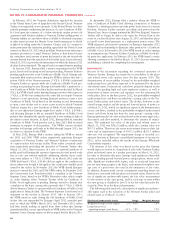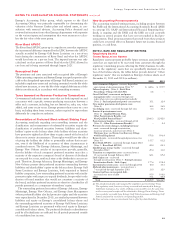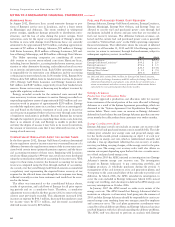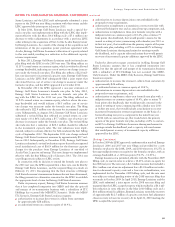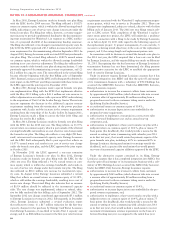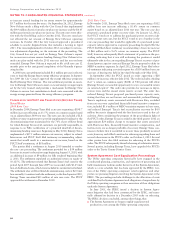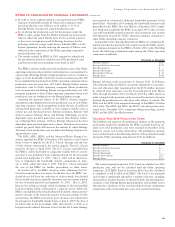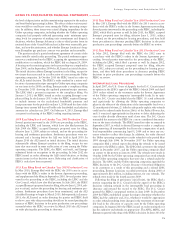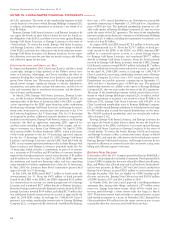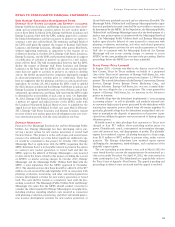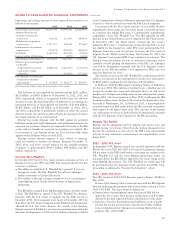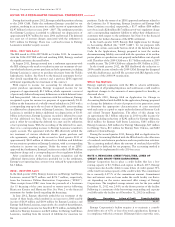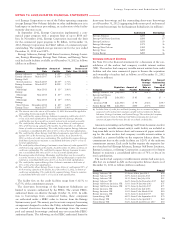Entergy 2012 Annual Report Download - page 72
Download and view the complete annual report
Please find page 72 of the 2012 Entergy annual report below. You can navigate through the pages in the report by either clicking on the pages listed below, or by using the keyword search tool below to find specific information within the annual report.
Entergy Corporation and Subsidiaries 2012
NOTES TO CONSOLIDATED FINANCIAL STATEMENTS continued
ROUGH PRODUCTION COST EQUALIZATION RATES
Each May since 2007 Entergy has filed with the FERC the rates to
implement the FERC’s orders in the System Agreement proceeding.
These filings show the following payments/receipts among the Utility
operating companies are necessary to achieve rough production cost
equalization as defined by the FERC’s orders (in millions):
2007 2008 2009 2010 2011 2012
Payments Payments Payments Payments Payments Payments
(Receipts) (Receipts) (Receipts) (Receipts) (Receipts) (Receipts)
Entergy
Arkansas $ 252 $ 252 $ 390 $ 41 $ 77 $ 41
Entergy Gulf
States
Louisiana $(120) $(124) $(107) $ – $(12) $ –
Entergy
Louisiana $ (91) $ (36) $(140) $(22) $ – $(41)
Entergy
Mississippi $ (41) $ (20) $ (24) $(19) $(40) $ –
Entergy
New Orleans $ – $ (7) $ – $ – $(25) $ –
Entergy Texas $ (30) $ (65) $(119) $ – $ – $ –
The APSC has approved a production cost allocation rider for
recovery from customers of the retail portion of the costs allocated
to Entergy Arkansas. Management believes that any changes in the
allocation of production costs resulting from the FERC’s decision
and related retail proceedings should result in similar rate changes for
retail customers, subject to specific circumstances that have caused
trapped costs. See “Fuel and purchased power cost recovery, Entergy
Texas,” above for discussion of a PUCT decision that resulted in $18.6
million of trapped costs between Entergy’s Texas and Louisiana
jurisdictions. See “2007 Rate Filing Based on Calendar Year 2006
Production Costs” below for a discussion of a FERC decision that
could result in trapped costs at Entergy Arkansas related to its
contract with AmerenUE.
Entergy Arkansas, and, for December 2012, Entergy Texas,
records accounts payable and Entergy Gulf States Louisiana, Entergy
Louisiana, Entergy Mississippi, Entergy New Orleans, and Entergy
Texas record accounts receivable to reflect the rough production
cost equalization payments and receipts required to implement the
FERC’s remedy. Entergy Arkansas, and, for December 2012, Entergy
Texas, records a corresponding regulatory asset for its right to collect
the payments from its customers, and Entergy Gulf States Louisiana,
Entergy Louisiana, Entergy Mississippi, Entergy New Orleans, and
Entergy Texas record corresponding regulatory liabilities for their
obligations to pass the receipts on to their customers. The regulatory
asset and liabilities are shown as “System Agreement cost equaliza-
tion” on the respective balance sheets.
2007 Rate Filing Based on Calendar Year 2006 Production Costs
Several parties intervened in the 2007 rate proceeding at the FERC,
including the APSC, the MPSC, the Council, and the LPSC, which
have also filed protests. The PUCT also intervened. Intervenor tes-
timony was filed in which the intervenors and also the FERC Staff
advocated a number of positions on issues that affect the level of
production costs the individual Utility operating companies are per-
mitted to reflect in the bandwidth calculation, including the level of
depreciation and decommissioning expense for nuclear facilities. The
effect of the various positions would be to reallocate costs among
the Utility operating companies. The Utility operating companies
filed rebuttal testimony explaining why the bandwidth payments are
properly recoverable under the AmerenUE contract, and explain-
ing why the positions of FERC Staff and intervenors on the other
issues should be rejected. A hearing in this proceeding concluded
in July 2008, and the ALJ issued an initial decision in September
2008. The ALJ’s initial decision concluded, among other things, that:
(1) the decisions to not exercise Entergy Arkansas’s option to pur-
chase the Independence plant in 1996 and 1997 were prudent;
(2) Entergy Arkansas properly flowed a portion of the bandwidth
payments through to AmerenUE in accordance with the wholesale
power contract; and (3) the level of nuclear depreciation and decom-
missioning expense reflected in the bandwidth calculation should
be calculated based on NRC-authorized license life, rather than the
nuclear depreciation and decommissioning expense authorized by the
retail regulators for purposes of retail ratemaking. Following briefing
by the parties, the matter was submitted to the FERC for decision.
On January 11, 2010, the FERC issued its decision both affirming
and overturning certain of the ALJ’s rulings, including overturning
the decision on nuclear depreciation and decommissioning expense.
The FERC’s conclusion related to the AmerenUE contract does not
permit Entergy Arkansas to recover a portion of its bandwidth pay-
ment from AmerenUE. The Utility operating companies requested
rehearing of that portion of the decision and requested clarification
on certain other portions of the decision.
AmerenUE argued that its wholesale power contract with Entergy
Arkansas, pursuant to which Entergy Arkansas sells power to
AmerenUE, does not permit Entergy Arkansas to flow through to
AmerenUE any portion of Entergy Arkansas’s bandwidth payment.
The AmerenUE contract expired in August 2009. In April 2008,
AmerenUE filed a complaint with the FERC seeking refunds, plus
interest, in the event the FERC ultimately determines that bandwidth
payments are not properly recovered under the AmerenUE con-
tract. In response to the FERC’s decision discussed in the previous
paragraph, Entergy Arkansas recorded a regulatory provision in the
fourth quarter 2009 for a potential refund to AmerenUE.
In May 2012, the FERC issued an order on rehearing in the pro-
ceeding. The order may result in the reallocation of costs among the
Utility operating companies, although there are still FERC decisions
pending in other System Agreement proceedings that could affect
the rough production cost equalization payments and receipts. The
FERC directed Entergy, within 45 days of the issuance of a pend-
ing FERC order on rehearing regarding the functionalization of costs
in the 2007 rate filing, to file a comprehensive bandwidth recalcula-
tion report showing updated payments and receipts in the 2007 rate
filing proceeding. The May 2012 FERC order also denied Entergy’s
request for rehearing regarding the AmerenUE contract and ordered
Entergy Arkansas to refund to AmerenUE the rough production cost
equalization payments collected from AmerenUE. Under the terms of
the FERC’s order a refund of $30.6 million, including interest, was
made in June 2012. Entergy and the LPSC appealed certain aspects
of the FERC’s decisions to the U.S. Court of Appeals for the D.C.
Circuit. On December 7, 2012, the D.C. Circuit dismissed Entergy’s
petition for review as premature because Entergy filed a rehearing
request of the May 2012 FERC order and that rehearing request is
still pending. The court also ordered that the LPSC’s appeal be held
in abeyance and that the parties file motions to govern further pro-
ceedings within 30 days of the FERC’s completion of the ongoing
“Entergy bandwidth proceedings.”
2008 Rate Filing Based on Calendar Year 2007 Production Costs
Several parties intervened in the 2008 rate proceeding at the FERC,
including the APSC, the LPSC, and AmerenUE, which have also filed
protests. Several other parties, including the MPSC and the City
Council, have intervened in the proceeding without filing a protest. In
direct testimony filed on January 9, 2009, certain intervenors and also
the FERC staff advocated a number of positions on issues that affect
the level of production costs the individual Utility operating compa-
nies are permitted to reflect in the bandwidth calculation, including
70


